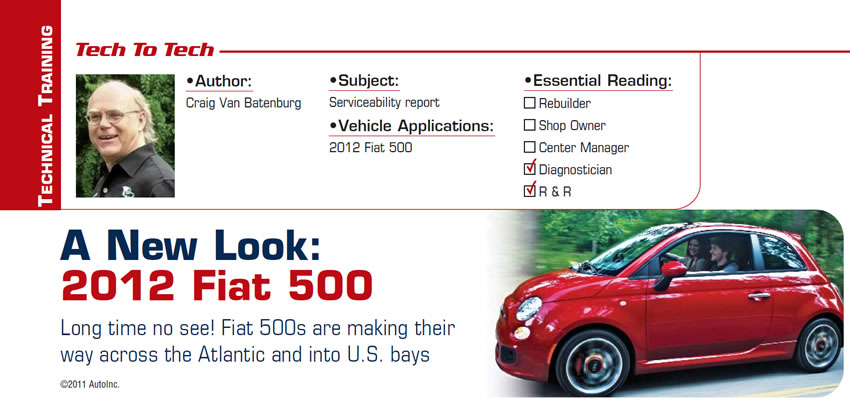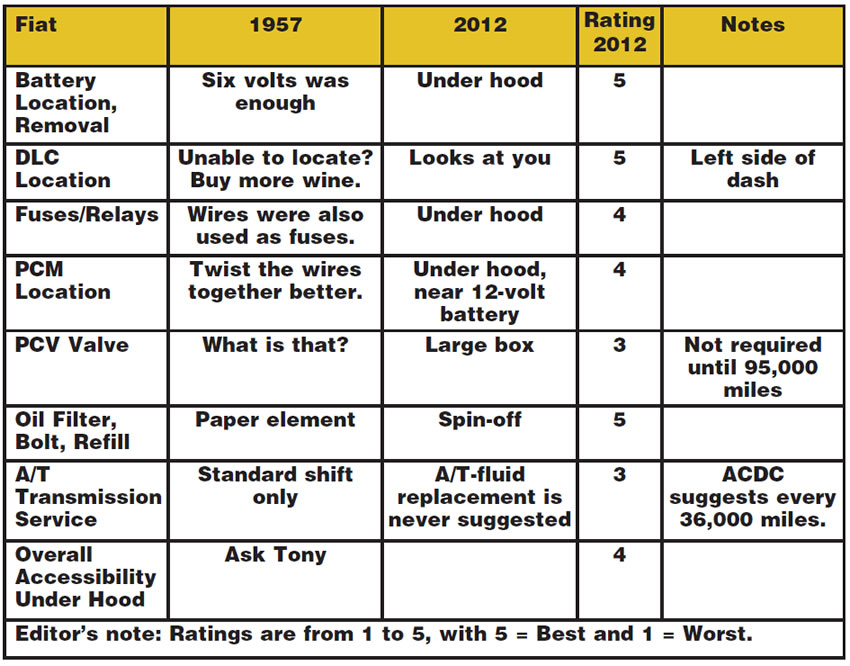
Tech to Tech
- Subject: Serviceability report
- Vehicle Application: 2012 Fiat 500
- Essential Reading: Diagnostician, R & R
- Author: Craig Van Batenburg, AAM
Long time no see! Fiat 500s are making their way across the Atlantic and into U.S. bays
“Fix It Again Tony” was the joke from the last adventure Fiat had in America. Well, thanks to Chrysler Motor Co. looking to the taxpayers for money, a deal was struck with Fiat to take it over and pay us all back. So far, so good. One benefit for Fiat is an instant dealer network that is now selling a small retro version of an Italian mini-car sold back in the ’50s. Is it any good? Or, more important, can the typical technician in the U.S. service this little vehicle, or should they stay away?
I have been writing this series to spotlight service issues that engineers may have designed or redesigned into an automobile that affects the hard-working technicians who get to service and fix them. Our job is tough enough without the parts being hard to find and even harder to replace. So let’s take a close look at the 500 by Fiat.
I was in Spain last October so I had a chance to ask many techs their take on this European car, and the Fiat 500 specifically. It was sold overseas for a few years before it was brought to the U.S. in 2011. Not many American technicians have worked on a Fiat – or if they did, they don’t want anyone to know. So this article, in this almost-decade-long series, didn’t fit my regular format because the car had been absent from our market for such a long time – and the new Fiat 500 is something we have never seen before. I have always liked a challenge, and this article gave me a chance for a new opportunity to test my investigative process.
I usually compare a previous version with a newly redesigned car of the same name, but this one is new so let’s go way back in time to compare the original 1975 Fiat 500 with the 2012 Fiat 500 sold in the U.S. today.

The base Fiat 500 sells for around $15,000 to $20,000, and sales are doing fine. A few months after the New York Auto Show – where I got some initial information about this newer vehicle – my wife, Deb, and I spent a day in New York with the 500. The car was fun – not very fast, but as a city car it is just fine. It is small, so it parks anywhere and handles well enough to make you feel confident as a driver. I was starting to like it. I also knew they were coming out with a Fiat 500 EV, which is more my style.
Fiat 500 1957-1975
The original was called a 500 because it was a 500cc car. It had all of 13 hp, was rear-drive with a two-cylinder air-cooled gasoline engine in the back with a four-speed gearbox. I had an opportunity to speak with Tony Molla, vice president of communications at ASE and a former Fiat technician, about his thoughts on the old 500s he used to repair. Small and simple, the 1975 Fiat 500s were unfettered with computerized engine controls, and the basic engine design was very familiar. Accessibility was good, and most major service was performed with the engine/transmission removed. Aside from corrosion issues, Molla said most maintenance service involved the normal brake, suspension etc. type of service and remembered doing a lot of wheel-bearing work on all Fiat models.
Molla did not recall disliking anything specific he had to work on back then, beyond dealing with the normal electrical quirks, which could be maddening.
Tune-ups involved the old reliable points, plugs, condenser routine, but the cap and rotor were usually replaced as well. The rest involved checking/setting ignition timing and carburetor adjustments.
The 500s were eventually phased out in the U.S. in favor of the newer, overhead single- and twin-cam designs that, in the late ’70s and early ’80s, saw the introduction of EFI systems and other emission-control improvements.
Born on July 4, 1957, it was more than just a car. It made history. It gave people the ability to move freely and with confidence. A liberating form of self-expression, the Fiat 500 was built to satisfy people’s insatiable love for each day.

The 2012 Fiat 500
With the car out for about three years in Europe, many of the bugs have been worked out by now. In the new configuration you will find a 1.4-liter inline four-cylinder under the hood with a front-wheel-drive system. The preventive maintenance required consists of fluid changes, filters, brake inspections and some hard parts at 32,000 miles. Access under the hood is typical for a transverse layout, and the 12-volt battery is right where you would expect. No surprises.
With fewer than 300 dealerships, sales so far are outpacing the Mini (by BMW), so this niche of retro small European cars may get bigger. Baby Boomers remember the 500 from the movies we watched as kids and for the privileged few who traveled to Europe back then and saw them firsthand. The EPA mileage for this four-passenger car is between 30 and 40 miles per gallon.
MultiAir is a new Fiat-designed electro-hydraulic system of engine-valve operation. It has dynamic and direct control of all intake valves. Thanks to the direct control of the air through the intake valves without using the throttle, MultiAir helps reduce fuel consumption; pollutant emissions are likewise reduced through combustion control. MultiAir is a versatile technology, easily applicable to all gasoline engines and with future potential developments also for diesel engines. Don’t let the word “air” confuse you. This is a design that uses a camshaft that works the valves with a computerized oil-control system that can (must) interfere with the motion of the camshaft and the movement of the valves. It is infinitely adjustable and unique.
Built in Michigan, the 1.4-liter, four-cylinder MultiAir engine produces 101 hp at 6,500 rpm and 98 lb.-ft. of torque at 4,000 rpm. MultiAir technology maximizes performance and minimizes emissions, basically by fine-tuning the intake-valve timing and lift, says Joe Grace, a Fiat vehicle-line executive.
Fiat also has “eco:Drive,” software you download to a personal computer, used in conjunction with a special Fiat memory stick that connects to the DLC to collect data. Once the memory stick is plugged into the driver’s PC, the system presents the Fiat 500’s detailed environmental performance, including the CO2 emission level for each trip. In addition, the eco:Drive application analyzes the driver’s style and provides recommendations on how to modify you driving style to help reduce fuel consumption and CO2 emissions.
Summary
Take these cars in when they show up. The timing belt is due for changing at 152,000 miles. While some service-information sources list the 500, not much information is online yet as the car is so new to the U.S. But the Dutch technicians I know work on them and tell me good things.
The old Fiat 500 is, for most people, a quirky car that made us smile long ago – and for a few Americans provided work. The new Fiat is exactly that, new. If I hadn’t been teaching in Europe every year for quite some time, I would have written a different story, but I now have a more-firsthand view of a large part of the car-producing world. Only time will tell whether this Fiat will stay together, but it looks quite likely that this little car will slowly change the jokes of the past.

Craig Van Batenburg, AAM, is a Master Hybrid Technician. He was the owner and lead technician for more than 25 years at his own shop that specialized in Honda and Toyota vehicles. Van Batenburg was the president of ASA-Massachusetts from 1993 to 1996. He is owner of the Automotive Career Development Center (ACDC), which he founded in 1998. He develops technical classes for those who require updating their knowledge in hybrid and electric cars. Some of his customers include the U.S. Army, U.S. Marines, Delphi, Midtronics, John Deere, Porsche of America and BG Products. You can reach Van Batenburg at [email protected].
This copyrighted article is reprinted with the permission of AutoInc., the official publication of the Automotive Service Association (ASA). To learn more about ASA and its commitment to independent automotive-service and repair professionals, visit www.ASAshop.org or call 800-272-7467.













